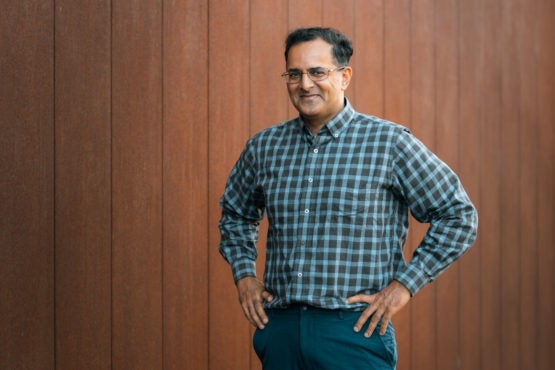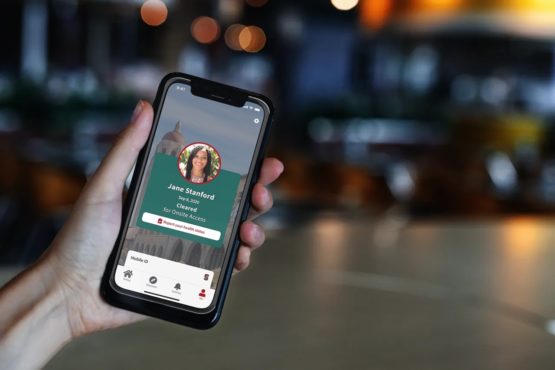Innovative tools bolster Stanford’s COVID-19 surveillance testing program
Health Check and COVID dashboards work in tandem with Stanford’s testing program for those working on campus and as the university makes decisions on increasing the number of students and employees who can return.
Alongside Stanford’s surveillance testing program, two innovative tools provide a steady flow of information to and about the campus community. From development to implementation, they reflect Stanford’s collaborative approach to addressing urgent challenges.

Clinical Assistant Professor Rajan Puri is an occupational physician and director of Strategic Health Initiatives and Innovation. (Image credit: Andrew Brodhead)
Health Check, which screens individuals before they come on site, and the COVID dashboards, which share testing results with the community, work in tandem with the testing program – supporting and informing the phased recovery of campus operations.
They are part of Stanford’s approach to protecting the university community, offering additional flexibility where risk levels allow and informing decisions about students and employees returning to campus.
Health Check
In late January and early February, Clinical Assistant Professor Rajan Puri and his colleagues at Stanford’s Occupational Health Center anticipated that the novel coronavirus would reach campus at some point. So the university would need a tool to gain information and limit its spread.
Three months later, in late May, the university rolled out Health Check to the campus community. It is a crucial tool for compliance with a Santa Clara County order requiring daily temperature and COVID-19 symptom screening for anyone working on campus.
“We needed something completely different in our arsenal to mitigate any spread to our students and employees,” said Puri, an occupational physician and director of Strategic Health Initiatives and Innovation. “We needed a new screening surveillance system, but one that was automated and could scale quickly to the entire campus community.”
Puri contacted the U.S. Centers for Disease Control and Prevention, which provided background medical guidance on potential hindrances to mitigating the spread. CDC officials also pointed him to the rise in cases in various locations – information that was not as readily available in the early days of the pandemic as it is today.
A large university campus, with individuals performing a diverse set of essential functions, presented certain challenges.
“The decentralized nature of our campus and the broad range of activities here required an innovative approach if we were going to be able to screen for symptoms effectively,” said Russell Furr, associate vice provost for environmental health and safety. “In a business or hospital, you usually only have limited entrances and it’s possible to just set up symptom check stations. But the nature of campus life at Stanford required a different solution.”
Converting that vision into a web-based tool required expediency, expertise, coordination and – like so many Stanford innovations – an interdisciplinary research effort.
“Our vision for the tool was to be simplistic on the front end with a dynamic user interface, targeting symptomatology, tests performed, exposure instances, recent travel and current isolation status,” Puri said.
Cooperation across campus
As vice provost and dean of research, Kathryn Ann “Kam” Moler oversees five shared research facilities and Stanford’s 18 independent labs, institutes and centers. She quickly threw her support behind the project, opening doors for Puri and his team.
“The research that our researchers conduct is so important – for its own sake, for the impact that it has on society and for the education of the students and postdocs who conduct much of the research,” Moler said. “It is a very high-value, relatively low-risk activity, and when I heard about Health Check, I knew that we should do it. Luckily, lots of other units on campus saw the value and we moved with unprecedented speed.”

University IT updated the Stanford Mobile app to incorporate Health Check. (Image credit: Courtesy Stanford University IT)
That cross-campus effort encompassed Environmental Health and Safety, Faculty Affairs, Office of the General Counsel, Human Relations, Occupational Health, Student Affairs, University IT and Vaden Health Services. The groups worked out a range of operational and policy issues.
For example, Occupational Health partnered with a University IT team led by Ganesh Karkala, associate vice president for enterprise technology, to design the application. UIT’s code and Occupational Health’s medical algorithm, which it was based on, were both built from scratch.
“We chose to remain in-house in hopes of greater collaboration, and the result was a dynamic environment that accelerated the process,” Puri said. “Our teams worked in unison.”
They needed to ensure the tool would be mobile friendly, accessible and fully available in both English and Spanish. It also had to link to the On-site Role Management System, or ORMS, which maintains the names of people authorized to pick up COVID-19 testing kits and to work on campus.
“We designed Health Check to sit atop our newest technology platforms,” said Stanford CIO Steve Gallagher. “This has enabled us to partner with the Occupational Health Center, Vaden, schools and business units to develop a rich suite of services. Health Check’s underlying architecture is highly flexible, so it can continue to evolve based on the university community’s needs.”
As part of a relaunch this summer, UIT also updated the Stanford Mobile app to incorporate Health Check. That enabled community members to use smartphones to report their daily health status, display their onsite-access badges and receive reminder notifications.
Health Check has received about 600,000 user submissions – currently about 7,500 on weekdays and 2,400 on weekends.
“The only reason this tool became a reality,” Furr said, “was because individuals from multiple organizations were willing to drop what they were doing and work across organizational lines to make it happen. Any top-down design process would have required years. Instead it has been a truly iterative design process that focused on building, testing, analyzing and refining.”
COVID dashboards
A companion tool, Stanford’s COVID dashboards, launched in September.
“We needed a way to demonstrate the outcomes of our mitigation efforts to the public and within the Stanford community, and the dashboard helps us provide transparency, instill confidence and decrease anxiety in a time of uncertainty,” said Puri, whose team designed and manages the dashboards. “Testing and these platforms allow us to see hints at what’s about to come before they actually arise.”
The dashboards’ graphical displays show the results of the university’s surveillance testing program, which began in late August.
They report results of surveillance tests for students, faculty, staff and postdoctoral scholars, numbers of positive test results and the positivity rate, as well as comparative metrics for the state of California and Santa Clara County.
The dashboards provide cumulative data since March 2020 for positive test results known to Stanford – from any testing provider – both among students living on campus or nearby, and faculty, staff and postdoctoral scholars whose test results were made known to Stanford and verified by a Stanford clinician.
“Health Check and the dashboards have been and remain critically important in Stanford’s COVID effort for providing the details and context needed for reasoned, well-informed decisions,” Puri said. “This is both from a practical and safety perspective at the personal and managerial levels for those coming onto campus, but also for policymakers at the highest levels of the university.”
